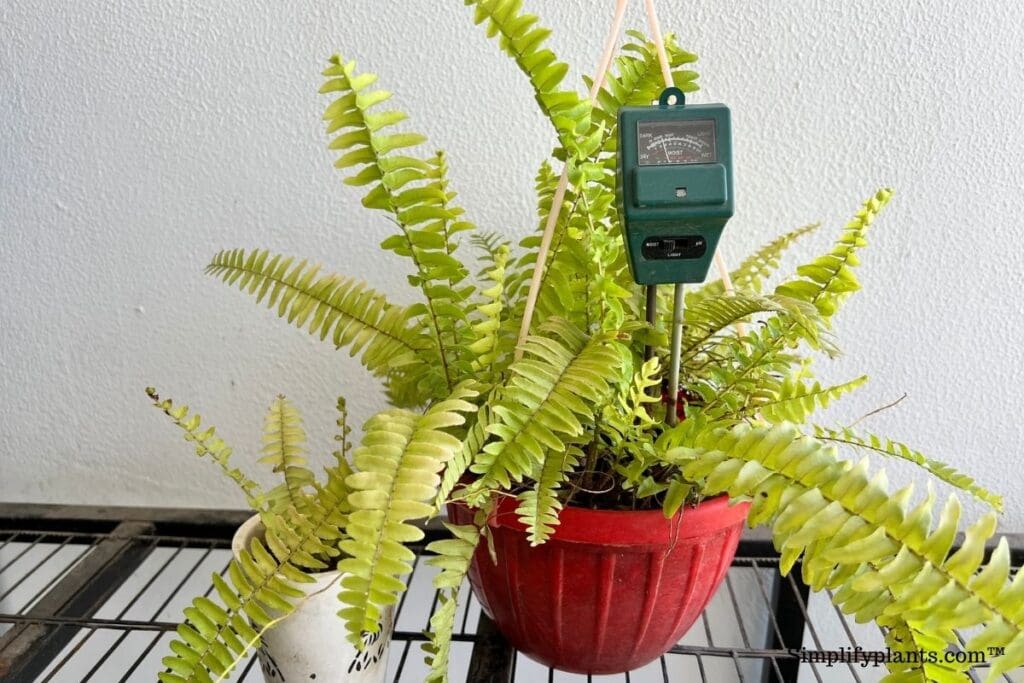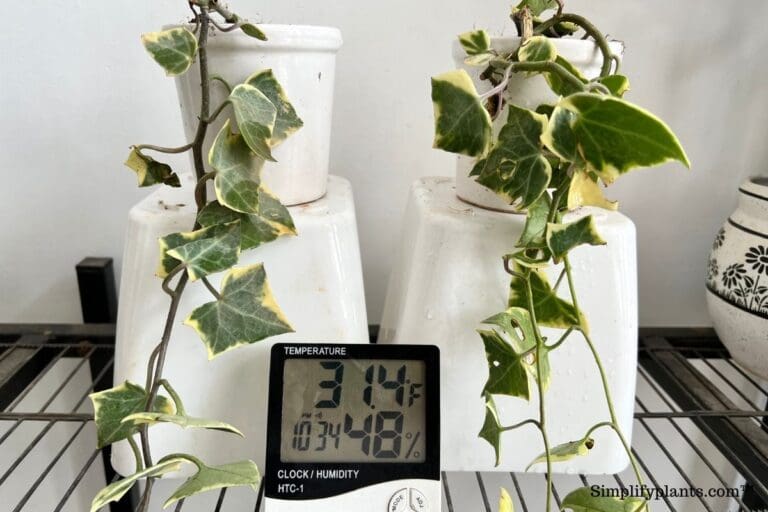Why Is My Boston Fern Leggy? (Causes+How To Fix)
Boston fern is a famous tropical houseplant known for its feathery ferns. But when this plant grows long with fewer leaves, it means your Boston fern is leggy.
Inadequate lighting, lack of pruning, and improper fertilization are the primary reasons why a Boston fern turns leggy. To fix the issue, prune the plant, fertilize during the growing season and move it to a spot where it gets adequate light and humidity to thrive.
If you want to understand why your Boston fern is growing leggy, you will get to know every possible reason and the fixation in this article.

Please note: Simplify Plants is reader-supported. Some links in the post are affiliate links and I get a commission from purchases made through links in the post.
Why is my Boston fern leggy?
Leggy Boston fern will have long, weak branches and stems with fewer leaves.
Various reasons can cause leggy growth in a plant.
The most common reason is lack of light.
Let us first discuss how light affects the plant’s growth, and then we will go through all the other causes with the possible cure.
Lack of light
Boston ferns prefer bright indirect sunlight to grow efficiently.
But if the plant fails to get enough light, it can turn leggy.
Lack of light slows down the photosynthesis process, resulting in an inadequate amount of nutrients and energy for the Boston fern plant.
Due to a lack of nutrients and energy, the plant stretches itself towards the bright sunlight to meet its demand.
Because of this action, the plant becomes extremely weak and grows thin with fewer leaves.
But keep in mind that direct light can cause sunburn to your Boston fern, so never expose the plant to that.
Also read: What Kind Of Lighting Does A Boston Fern Need?

Irregular pruning of Boston fern
Many people don’t prune their plants because they think they will become bushier and taller.
But, this is not the truth.
If you delay pruning, it will promote uneven and lateral growth of your Boston fern plant.
Lack of pruning makes the Boston fern grow uneven.
Those extra leaves take up all the energy, moisture, and nutrients needed to strengthen the stems, branches, and roots.
Giving nutrition to extra and uneven parts within that restricted soil causes stress and leads to a leggy plant.
Regular pruning will help your plant remain in an even shape and stimulate healthy growth.
You should prune your Boston fern regularly during their growing season; otherwise, you will get to see leggy growth.
Underfertilization
If you don’t fertilize your Boston fern properly, it will fail to get the necessary nutrients to promote new and healthy growth.
This plant needs to be fertilized once a month during its growing season, i.e., summer and spring.
If you fail to do that, the plant will grow leggy.
Due to the absence of necessary nutrients, the Boston fern will become weak, failing to grow strong stems and leaves.
This leads to leggy growth in Boston fern.
Also read: Should I Fertilize My Boston Fern? (Ideal Fertilizer+When & How Much)
Overfertilization

Fertilizing your Boston fern frequently with a higher amount can cause overfertilization.
Overfertilization can lead to various health issues, and among them, leggy growth is the most common one.
No one likes to see their plant growing slowly.
Because of this reason, many houseplant owners start to fertilize their plants frequently to promote fast growth without knowing that it can be very harmful to the plant.
Nitrogen is mostly used for stimulating new and faster growths.
Using a fertilizer with a higher Nitrogen level can make your plant grow taller with a few leaves.
Also read: Why Is My Boston Fern Drying Out? (Causes+How To Fix)
Temperature fluctuations
The ideal temperature for Boston fern is 60-75ºF.
Since this plant prefers warm temperatures to thrive, when the temperature drops below 45ºF, it gets stressed.
Temperature fluctuations can cause disturbance in the natural processes of plants, such as respiration, photosynthesis, transpiration, etc., which cause extreme stress.
When you introduce the plant to an unfamiliar temperature, it fails to adjust to the surroundings and becomes unhealthy.
This makes the Boston fern plant weak, and it starts to grow thinner and weaker with fewer leaves.
To prevent legginess in your plant, try to protect it from the unsuitable temperature at any cost.
Also read: Boston Fern Temperature Tolerance: +Ideal Temperature
Not watering properly

If your Boston fern is not watered properly, it fails to get adequate nutrients, moisture, and energy.
This makes the plant’s stems extremely weak, losing all of its leaves.
Later on, the plant starts to grow unevenly.
Overwatering can also cause leggy growth in a plant.
When your Boston fern remains in a damp condition for too long, it gets attacked by various pests and fungal diseases.
These pests and fungal diseases damage the plant’s cells making the stems weak and sagging.
This leads to a leggy growth.
Also read: How To Water Boston Fern? (How Often, How Much & More)
Rootbound problem
When the Boston fern continues to grow in a limited space for too long, the roots no longer get any space to grow further, and then it gets rootbound.
When they are rootbound, the soil content becomes less than the roots, so the plant fails to absorb nutrients and water from the limited soil.
This makes the plant weak and leggy due to a lack of energy and inadequate nutrition.
The plant will get rootbound when you don’t repot them for an extended period.
So you should stop delaying this and repot your Boston fern timely.
Also read: Do Boston Ferns Like To Be Root Bound? (+When To Repot)
Overcrowding

If you have kept too many houseplants together with Boston fern, it can get overcrowded.
Overcrowded houseplants become so congested that they fail to get sufficient sunlight to every part equally.
This causes unhealthy growth.
The plant grows long stems with a limited number of leaves because of overcrowding.
Also read: What Kind Of Pot Is Best For a Boston Fern? (Size, Material & More)
How to fix the leggy Boston fern plant?
After understanding all the possible reasons behind Boston fern, it’s time to recover your plant.
You should never ignore the signs of legginess and try to fix them without any delay.
Fixing non-pruned leggy Boston fern plant

If you get rid of the dead or damaged leaves on time, the plant gets space to grow new, healthy, and vibrant leaves.
Pruning also helps to keep the pests and fungal growth away.
The best time to prune your Boston fern is during their growing season, i.e., spring and summer.
If you haven’t pruned your Boston fern for too long and it has started to grow leggy, don’t waste any more time and immediately cut all the extra and leggy parts.
While pruning, keep the points in mind:
- Use sharp and sterilized pruners for making a healthy and sharp cut.
- Don’t cut the plant too deeply, and always make a minor cut to avoid stress.
- Get rid of all the leggy stems.
- If the buds restrict the plant’s growth, trim them off.
Fixing the low light problem
Every houseplant faces difficulties if they grow in a low light area.
If your Boston fern has turned leggy because of insufficient light, try to provide enough light.
To fix this problem, move the plant to a bright location, for example, near a terrace, window, doors, and balcony, or in any area where the plant will get sufficient light.
Cut the dormant parts of Boston fern and then clean the leaves so that they can absorb proper light from the sun.
Keep rotating your Boston fern frequently to provide light to every part.
If your Boston fern is not getting sufficient natural light, use artificial lights as an alternative.
You can get artificial light easily from any nearest shop.
Fixing fertilization issues

As we have already discussed before, both under-fertilization and over-fertilization can cause leggy growth.
Now, let us discuss its solution.
- At first, prune all the damaged leaves, stems, branches, and dormant buds before taking any steps for recovering.
- Fertilize your Boston fern with a water-soluble fertilizer with an NPK ratio of 20-10-20.
- Always dilute the fertilizer with water to make it half-strength, and then use it.
- Fertilize the Boston fern once a month during its growing season to provide nutrients timely.
- If your Boston fern is overfertilized, stop fertilizing till the Boston fern overcomes the stress and shock.
- If you have recently overfertilized and it has not gone to the depth yet, remove the top 2-3 inches of the soil and add a new layer.
- But if the situation is bad, then change the entire soil by repotting. Gently take the roots from the current soil, then cut the infected roots off. After that, repot the Boston fern in a new pot with a fresh layer of soil mix.
- After repotting successfully, take good care of the plant to keep it away from stress.
- Changing the soil is the best choice to recover the plant from over-fertilization.
Fixing improper watering
Watering too frequently or too little can cause leggy growth to your Boston fern.
- If the soil is too dry, water the plant until the soil is completely soaked and the excess water comes out of the drainage holes.
- Also, add a layer of mulch to the soil to increase moisture retention.
- To keep the plant moisturized, try to increase the humidity. You can either mist the plant or use a humidifier device.
- But when the soil is too soggy, place the plant in a bright location so that the water will evaporate quickly and don’t water until the soil gets dry.
- Try to check the condition of the roots by taking them out from the soil. If you see the roots are healthy, you can simply wait for the roots to dry and then plant the roots back into the soil.
- But if the roots are damaged, repot the plant by cutting the infected or injured roots. Make sure you don’t use a previous soil but add a fresh new one.
Fixing temperature fluctuations

Temperature fluctuations can cause stress to an extreme level, so try to protect your Boston fern from it.
- If you keep your plant outside during low temperatures, bring the plant inside the house.
- Don’t keep your Boston fern near windows or doors that open and close too frequently. Relocate the plant somewhere else where the temperature remains stable.
- Keep your Boston fern away from heating sources like fireplaces, vents, radiators, heaters, etc.
- Don’t change the plant’s location too often, and try to provide a stable environment.
- Keep checking the temperature inside the house by using a thermostat device or a hygrometer. This will help you know the temperature at which your plant is growing and then try to maintain it.
Fixing a rootbound Boston fern
Rootbound is a serious issue, and if not treated early, it can even kill your plant.
But you can fix this by repotting.
- For repotting, choose a pot that is larger than the previous pot. And also, it should contain drainage holes.
- Use a soil mix that has good moisture retention and proper drainage.
- Be careful while pulling out the roots from the pot not to harm the healthy roots. First, spread the roots slowly with your hands, prune the damaged roots, and then transfer the Boston fern to a new pot.
- Even a slight injury can cause stress to the Boston fern. After repotting, give the plant its proper ideal condition and ensure you don’t ignore its basic needs.
How to prevent legginess in Boston Ferns?

After fixing your leggy Boston fern, you need to take good care of your plant to prevent legginess in the future.
Let us see all how you can prevent legginess.
- Try to find out the light requirements of your Boston fern and then choose a spot according to that. Boston fern loves indirect sunlight so keep the plant where it will receive at least 2-3 hours of indirect sunlight.
- Keep rotating the entire plant frequently to provide light to every part. If natural light is not enough, then use artificial lights.
- Feed your plant during summer and spring with a liquid fertilizer with an NPK ratio of 20-10-20. Make sure you apply the fertilizer only after making it half-strength by diluting it with water.
- If you notice damaged leaves or stems, prune them off. This will not only prevent leggy growth but will also encourage the plant to grow healthier. Try to prune from the nodes for better results.
- Boston fern enjoys growing in moist soil so never let your plant suffer from dry conditions. Water your Boston fern after checking whether the topsoil is 25% dry or not. If yes, then start watering your plant, but if not, then wait for some time till the soil gets dry.
- Always repot your Boston fern on time. Take the plant out from the pot, space them out, and cut the injured roots. Choose a pot 2-3 inches larger than the old one and use a fresh potting mix.
- Don’t keep other houseplants too close to the Boston fern. Try to give some space to avoid legginess.
- Avoid keeping your Boston fern near objects like heaters, radiators, vents, air conditioners, and coolers. Always protect the plant from hot or cold drafts to keep it away from stress.
FAQ
What does a leggy Boston fern look like?
Let us see the signs of a leggy Boston fern plant.
- Weak and elongated stems
- Too much gap between the leaves
- Unequal growths
- Plant lean from one side.
- No longer new growths
Leggy Boston fern gives a very untidy look, so it’s better to protect the plant from leggy growth.
How to prune a leggy Boston fern?
Pruning a leggy plant is the same as pruning a normal one.
Try to prune the plant from its node to encourage fast and new growth.
If you want to remove the stem, cut it nearer to the base of the main stem.
You can also remove the tips to help your plant grow freshly.
Reference: University of Florida, The University of Arkansas Division, Texas A&M University System, The University of Georgia, University of New Hampshire, Wikipedia, The Royal Horticultural Society.
Recommended Garden Supplies
| Product Image | Our Recommended Gardening Supplies | Check Offers! |
|---|---|---|
Top Top
Top
Top
Top
Top
Top
Top
Top | rePotme Houseplant and Tropical Classic Potting Soil Mix | Check Offer On Amazon |
 Top
Top
Top
Top
Top
Top
Top
Top | Espoma Organic Indoor Plant Food | Check Offer On Amazon |
 Top
Top
Top
Top
Top
Top
Top
Top | GooingTop LED Grow Light 6000K Full Spectrum Clip Plant Growing Lamp | Check Offer On Amazon |
 Top
Top
Top
Top
Top
Top
Top
Top | Soil Moisture Meter | Check Offer On Amazon |
 Top
Top
Top
Top
Top
Top
Top
Top | Govee Hygrometer Thermometer, Bluetooth Enabled! | Check Offer On Amazon |
 Top
Top | LEVOIT Humidifiers for Large Room(Best For Plants) | Check Offer On Amazon |
 Top
Top
Top
Top
Top
Top
Top
Top | Upgraded DIY Automatic Drip Irrigation Kit, 15 Potted Houseplants Support | Check Offer On Amazon |
 Top
Top
Top
Top
Top
Top
Top
Top | Stainless Steel Heavy Duty Gardening Tool Set | Check Offer On Amazon |
 Top
Top
Top
Top
Top
Top
Top
Top | Bonide Insecticidal Soap | Check Offer On Amazon |
 Top
Top
Top
Top
Top
Top
Top
Top | Bonide 32 oz Spray Neem Oil for Organic Gardening | Check Offer On Amazon |
 Top
Top
Top
Top
Top
Top
Top
Top | Garden Safe Fungicide | Check Offer On Amazon |






